
Five-second rule: Teams will be no longer be able to keep the ball at the back of a ruck for a long period
THIS SEASON five law amendments are being trialled across the globe in both domestic and international games, including the speeding up of rucks.
One of the key changes being trialled – from August 2012 in the northern hemisphere and January 2013 in the South – is a limit on the time that the ball is available at the back of a ruck before being played. If teams fail to play the ball within five seconds of the referee calling “use it”, the defending team will be awarded a scrum.
If the ball goes into touch from a knock-on, teams will also be able to opt for a lineout rather than a scrum – and that includes being able to take a quick throw-in.
The five law amendments to be trialled in full are:
1. Law 16.7 (Ruck): The ball has to be used within five seconds of it being made available at the back of a ruck following a warning from the referee to “use it”. Sanction – Scrum.
2. 19.2 (b) (Quick Throw-In) For a quick throw in, the player may be anywhere outside the field of play between the line of touch and the player’s goal line.
3. 19.4 (who throws in) When the ball goes into touch from a knock-on, the non-offending team will be offered the choice of a lineout at the point the ball crossed the touch line; or a scrum at the place of the knock-on. The non-offending team may exercise this option by taking a quick throw-in.
4. 21.4 Penalty and free kick options and requirements: Lineout alternative. A team awarded a penalty or a free kick at a lineout may choose a further lineout, they throw in. This is in addition to the scrum option.
5. A conversion kick must be completed within one minute 30 seconds from the time that a try has been awarded.
The IRB is also trailling an extension of the TMO’s powers, with video referees allowed to look at foul play and incidents in the lead up to tries, such as forward passes. In the Aviva Premiership, referrals to the TMO can now go back to the previous restart (set-piece, penalty/free-kick, kick-off or restart), while in South Africa’s Currie Cup referrals could only go two phases back.
During the autumn Tests, teams are able to pick an extra front-row player on the bench to take the number of replacements to eight.
There has been an increase in the number of replacements allowed in a sevens match, with teams able to substitute up to five players.
The final review announced by the IRB concerned the growing controversy at scrum time. The Laws Representative Group is already looking into issues at the scrummage and after successful trials they have been asked to consider a change to the calling sequence. Instead of the current ‘Crouch, touch, pause, engage’, it is being proposed that the referee calls: ‘Crouch, touch, set’.
IRB chairman Bernard Lapasset said: “We have a collective responsibility to ensure that the Game is as enjoyable to play, officiate and watch as possible at every level while player welfare is of paramount importance.”
The IRB now want your opinion on how the law trials are working this season before they decide to bring any of them into force permanently. To give your views on the trials, just complete this quick survey – it’s available in English, French and Spanish.







